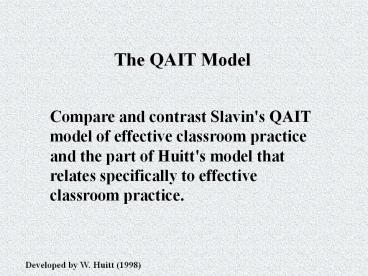Slavin's QAIT Model - PowerPoint PPT Presentation
1 / 18
Title:
Slavin's QAIT Model
Description:
... QAIT model of effective classroom practice and the part of Huitt's model ... Slavin's QAIT Model of Effective Classroom Practice ... – PowerPoint PPT presentation
Number of Views:1201
Avg rating:3.0/5.0
Title: Slavin's QAIT Model
1
The QAIT Model
Compare and contrast Slavin's QAIT model of
effective classroom practice and the part of
Huitt's model that relates specifically to
effective classroom practice.
Developed by W. Huitt (1998)
2
Slavins QAIT Model of Effective Classroom
Practice
- Robert Slavin's QAIT model is a revision of John
Carroll's model of school learning.
- Slavin eliminated those elements that were not
under the control of educators and kept or
redefined elements those elements that could be
ALTERED or MODIFIED by teachers.
- According to Slavin, all of the elements must be
present if classroom learning is to be effective.
3
Slavins QAIT Model of Effective Classroom
Practice
While Carrolls model included five elements,
Slavins model includes only four
Quality of instruction
- The degree to which information or skills are
presented so that students can easily learn them
- Slavin provides a model of DIRECT INSTRUCTION
that he believes incorporates the essential
elements of quality instruction.
4
Slavins QAIT Model of Effective Classroom
Practice
While Carrolls model included five elements,
Slavins model includes only four
Appropriate levels of instruction
- The degree to which the teacher makes sure that
students are ready to learn the lesson (that is,
have the necessary skills and knowledge to learn
it) but have not already learned the lesson.
5
Slavins QAIT Model of Effective Classroom
Practice
While Carrolls model included five elements,
Slavins model includes only four
Appropriate levels of instruction
- Slavin has redefined Carroll's variable ABILITY
TO UNDERSTAND INSTRUCTION which is a STUDENT
CHARACTERISTIC and made it a TEACHER CLASSROOM
BEHAVIOR.
6
Slavins QAIT Model of Effective Classroom
Practice
While Carrolls model included five elements,
Slavins model includes only four
Incentive
- The degree to which the teacher makes sure that
students are motivated to work on instructional
tasks and to learn the material being presented.
7
Slavins QAIT Model of Effective Classroom
Practice
While Carrolls model included five elements,
Slavins model includes only four
Incentive
- Slavin has redefined Carroll's variable
PERSEVERANCE which is a STUDENT CLASSROOM
BEHAVIOR and again made it a TEACHER CLASSROOM
BEHAVIOR.
8
Slavins QAIT Model of Effective Classroom
Practice
While Carrolls model included five elements,
Slavins model includes only four
Time
- The degree to which students are given enough
time to learn the material being taught.
9
Slavins QAIT Model of Effective Classroom
Practice
While Carrolls model included five elements,
Slavins model includes only four
Time
- Slavin has redefined Opportunity as a TEACHER
CLASSROOM BEHAVIOR.
10
Comparing Slavins and Huitts Models of
Effective Classroom Behavior
- Slavin's QAIT model can be contrasted with the
Classroom Processes section of Huitt's model of
the teaching/learning process.
11
(No Transcript)
12
Comparing Slavins and Huitts Models of
Effective Classroom Behavior
- Huitts consideration of Effective Classroom
Behavior is a slight adaptation of the Dimensions
of Classroom Effectiveness developed by Squires,
Huitt, and Segars (1983). - Squires, D., Huitt, W., Segars, J. Effective
classrooms and schools A research-based
perspective. Alexandria, VA Association for
Supervision and Curriculum Development.
13
(No Transcript)
14
Comparing Slavins and Huitts Models of
Effective Classroom Behavior
Major difference between Slavin's and Huitt's
models
- Slavin redefined important variables in
Carroll's model into Teacher Classroom Behavior
variables.
- Slavin emphasized the importance of the
classroom teacher in arranging the conditions
that will optimize student learning.
- Has simultaneously eliminated consideration of
student classroom behavior as an important
classroom behavior.
15
Comparing Slavins and Huitts Models of
Effective Classroom Behavior
Huitt's view of important classroom processes
emphasizes the interaction between teachers and
students.
Content Overlap
Planning
Management
Involvement
Success
Instruction
16
Comparing Slavins and Huitts Models of
Effective Classroom Behavior
- Teacher student interaction produces the
transactional cycle that is the focus of the
teaching/ learning process.
- From this perspective, both teachers and
students are responsible for classroom learning.
- Teachers are responsible for arranging
conditions for learning.
- Students are responsible for paying attention
and striving for success.
17
Comparing Slavins and Huitts Models of
Effective Classroom Behavior
Quality of Instruction
Classroom Instruction
Appropriate Levels of Instruction
Classroom Management
Incentive
Time
18
Comparing Slavins and Huitts Models of
Effective Classroom Behavior
- Slavin has implied, although not explicitly
stated, that teachers should be concerned about
- Student Engaged Time
- Student Success
- Slavin, like Carroll, has not considered two
aspects of classroom behavior that Huitt believes
important
- Teacher Planning
- Content Overlap or Time-on-Target

